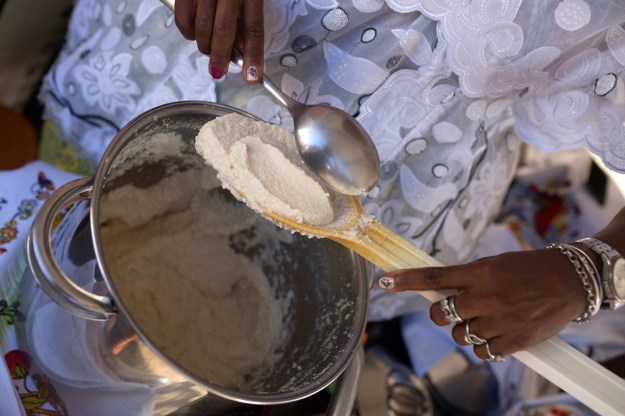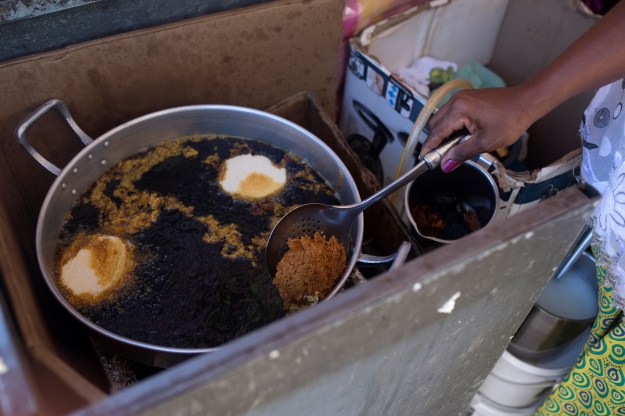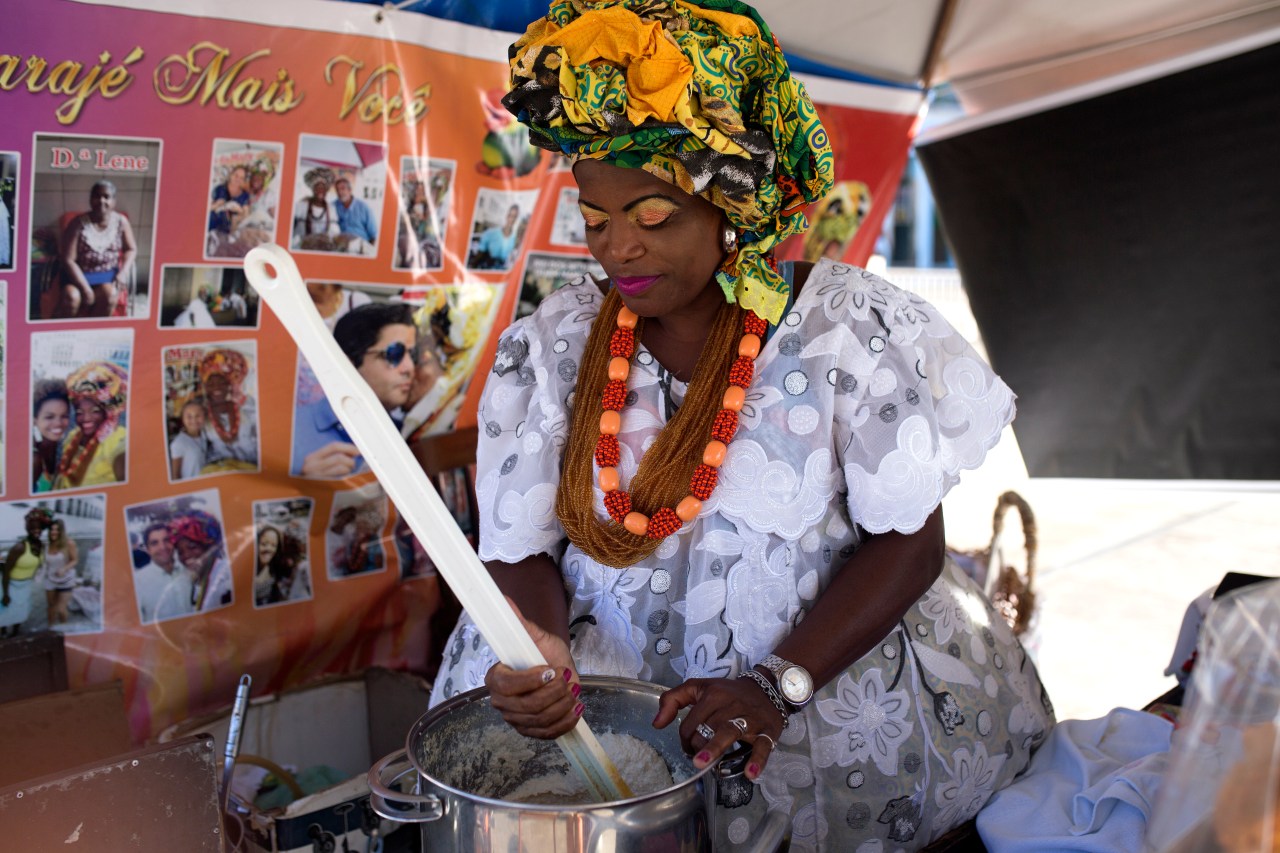Every day before heading off to work, Cida Afonja takes a few extra minutes to make sure that she is dressed just right. She delicately places swishing petticoats and a long, flowing white skirt—always white—on top of white cotton pants. On her head she wraps a layered headscarf. As a final touch, colorful necklaces are placed over the fabric, earrings are fixed, and then there are the bangles, lots of them.
“It’s more than a costume; it’s a uniform,” she says. But it is one that links her to traditions that grew as Brazil did, nodding toward both European colonizers and the African slaves on the backs of whom the country developed. Moreover, the uniform represents an identity that Afonja and others have had to fight to keep pure, as some see it, immune from the twin attacks of religious homogenization and commercialization.
Afonja is a baiana do acarajé, as the women who sell Afro-Brazilian food in the streets of Bahia are known. The state in northeast Brazil is known as much for its wild Carnival parties as for its beautiful coasts.
The Portuguese first arrived in what is now known as Brazil in 1500, bringing with them their own rich and diverse culinary canon. In the 1500’s, the colonial power began bringing African slaves to Brazil’s shores.The subsequent fusion of cooking styles and tastes of Africa with Portuguese and indigenous food cultures became the foundation of what we know today as Brazilian cuisine.
Acarajé is a culinary embodiment of this process: a black-eyed-pea-and-shrimp fritter, light in texture and bold in flavor. The dendê (red palm oil), in which it is deep-fried, and the vatapá (seafood stew with coconut milk) that serve as a base for the delicacy make acarajé a symbol of the distinctive richness of Bahia’s food culture.
But the care Afonja, who has been selling acarajé since 1994, takes in protecting the traditions around the dish is not shared by all. In recent years there has been a noticeable uptick in women selling acarajé without worrying about some of the details that have become pillars of the profession. Although vendors risk fines by selling acarajé while dressed in an apron and a regular shirt, casual dressers have become more common.
This is less the result of Bahia’s climate—during the heat of the summer temperatures can exceed 104 degrees Fahrenheit, making multilayer clothing less than ideal—and more about religious tension. The traditional dress worn by Afonja and others is part of Candomblé, and pays homage to the deities of the Afro-Brazilian religion rather than Catholicism, the country’s predominant denomination.
Thought to be practiced by as many as two million followers, according to the BBC, the syncretic religion was initially a way for enslaved people to maintain their African religions while seeming to adhere to Catholicism, primarily in order to appease Portuguese colonizers keen to convert all to Christianity. Condemned by the Catholic Church, Candomblé was for much of its history worshipped largely in secret. But since the fall of the Brazilian military dictatorship in the 1980s, practitioners have been able to hold ceremonies more openly, prompting a revival of the religion, especially in the northeast of the country, where many residents are of African decent.



Adherents of Candomblé worship Orishas, African deities treated similarly to Catholic saints, each with a distinct name and favorite food. In Candomblé, the recipe for acarajé that Afonja and others sell was created as an offering to Iansã, the goddess of the winds and storms.
But as Bahians have, along with the greater Brazilian population, become more evangelical in recent years (based on the 2010 census, more than 2 out of 10 Brazilians are currently evangelicals), some street sellers have become reluctant to wear the traditional garb, saying that to do so would be against their religious beliefs.
Attempts to distance the dish from Candomblé peaked recently when a group of evangelical Bahians attempted to rename acarajé “Jesus’ fritter.”
Members of the Candomblé community objected and obtained an injunction forbidding the sale of the delicacy under that name. “Everybody knows that acarajé is the votive food of Iansã. It’s not Jesus’ fritter,” says Afonja. “Our food is one of the major symbols of our Afro-descendant culture. The ingredients, the clothes, and the name are related to that. Not respecting this is not respecting our roots,” she continues.
Since July 2017 the profession of baiana do acarajé has been officially recognized by the Brazilian government, prompting sellers to begin registering as individual microentrepreneurs. Over 10 years ago, the craft was awarded Intangible Heritage status by UNESCO and IPHAN (Brazil’s institute of historical heritage) safeguarding its place in Bahian culture. There are currently around 3,500 baianas in Salvador, Bahia’s capital, alone.
According to IPHAN, these steps were put in place to help preserve a tradition that has been passed from mother to daughter for generations. More than just acknowledging the recipe of the delicacy, the concept of “intangible cultural heritage” also refers to the techniques, rituals, and rites that center around the food, placing it in a larger context of culture and tradition.
“It is not the acarajé itself or its recipe that is the patrimony. The patrimony is in the craft work of peeling the beans, in the recipe’s relation between the sacred and the profane, in the act of turning that fritter into a religious reference, the Bahian dresses, the presentation of the food following specific rules,” explains Diana Dianovsky, registration coordinator of IPHAN’s Department of Intangible Heritage.
Since 2005, in accordance with the new rules, the baianas are supposed to wear a white blouse and skirt and a headscarf. As for the recipe itself, acarajé must be made with black-eyed peas, seasoned only with onion and salt and then fried in palm oil. In the filling, you find only the basics: chilies, more vatapá, and shrimp. It’s an attempt to stop some baianas from using less traditional fillings, such as lettuce and tomato.
The restrictions prompted some women to stop selling acarajé in the streets of Salvador altogether. But the Baianas do Acarajé National Association celebrated the standards, noting that the number of affiliates had not decreased significantly as a result—according to them, there are currently more than 4,000 registered sellers across Bahia.
Angelice Batista dos Santos, the association’s municipal coordinator, explained that many women, some of whom have been selling the delicacy for more than 40 years, continue to hawk acarajés for commercial reasons despite not adhering to the Candomblé religion or its traditions. “Like it or not, they need to follow the rules that keep our cultural ties preserved,” she says.
For Afonja, it is about more than just making a living. Her grandmother used to sell African products and ingredients at a market in Salvador. “It’s something that has been in my family for a long time”, she explains. Afonja says it is a tradition that passes through generations. “It is our mission to not let it disappear.” She is working—and praying—for that.